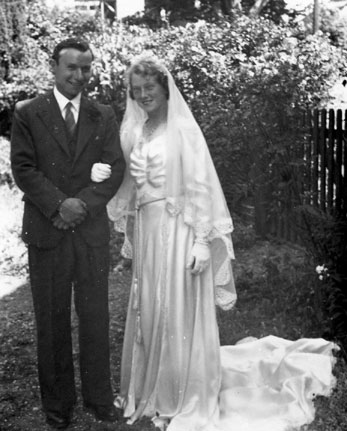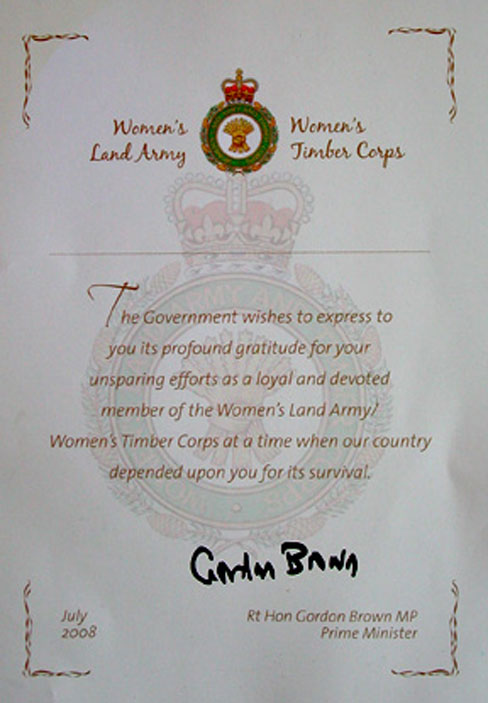Wartime Activities
Women’s Land Army WW2, local sisters get involved
and a forces style wedding. see below
An extract from ‘Land Girl. A Handbook for the Women’s Army’ containing advice for volunteer from the town on settling into the country.
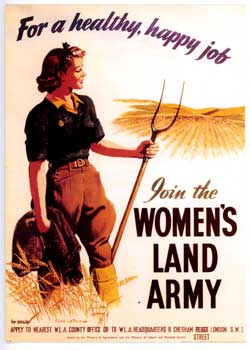
Making the most of the the country
The town girl does not often find it easy to live in the country. She naturally misses all the amenities that she is used to . She cannot pop into the local cinema when she feels inclined. She cannot even go round to the local fish and chip shop or to a snack bar if she wants a qhick meal in the evening. She is not able to stroll down the High Street and have a look in the shops and see the latest fashions, and there are not, of course, the number of men about to go to dances with at the local Palais de Dance.
Some townspeople are apt to look upon all country folk as country bumpkins. They have an idea that it is only the town folk who know anything, and because people in the country are not so slick, or are not so well dressed, or perhaps are not up to the latest fashion, they are apt to be labelled as old-fashioned, and rather a a back number.
Actually, country folk usually know far more than those who are bred and born in the towns and cities. They may not know all the names of the film stars and the pictures in which they have appeared, but they do know the names of the birds and their habits. They are able to to tell whether it is going to be wet or fine the next day. They know which herbs are useful and all about the ways of wild animals. They have different kinds of knowledge., that is all.
The Land Army volunteer, therefore, who is going to work on a farm and live in a village must be prepared to see the “other fellow’s” point of view. She will never be a success if she goes into her new surroundings determined to show them a thing or two. She will only be a stared at if she wears her very latest Bond Street creation at the local social or “hop.” She will be considered rude if she is continually saying, “Fancy you not knowing that”, or is constantly boasting of her doings in the town.
It does need a little effort at first to fit with new surroundings. It is always necessary to consider the farmer and his family; to consider the billeter, and to remember to help in the little things, and to lend a hand sometimes without being asked.
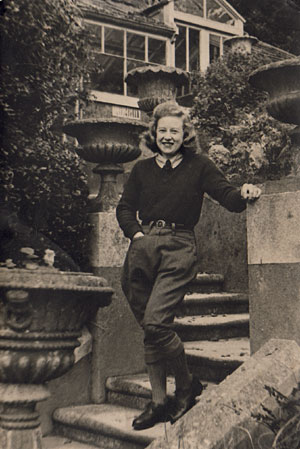
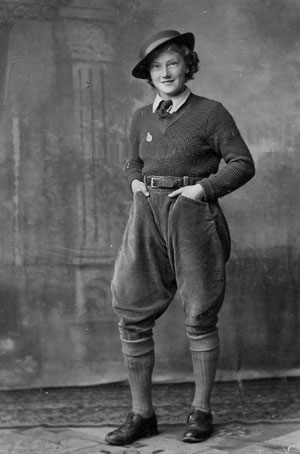
|
Mary Kightley
|
Sheila Kightley
|
|
—————————————————–
Recorded interview 6/7/2006 between Mary Penny nee Kightley and Brenda Pittam A local girl joins the Womens Land Army 1943
Mary can you tell me how you came to join the land army in the 1940s? I was doing a milk round for Knightons, then, when I was 17 I just thought I would like to join the Land Army so I went up to the recruiting office in Wolverton. I joined 6 months before I should have, because it was seventeen and a half to join. I went to work at Norman Gees. Was that your first job? ? No, I started at Poulsons, that was at Kerry farm. Did they milk? Yes. Were the milking sheds on the opposite side of the road? No they were next to the house. What was on the other side of the road? Nothing, only fields until the bungalow was built, there were no buildings there. I left there to go to Norman Gee’s. I was with the race horses but they said it wasn’t important enough so I left there and went to Sopers. Was it mainly racehorses there? No there was a farm as well. So then I went to Sopers and stayed there for 9 and a half years milking mainly and potato picking and delivering the milk until they sold the round. Did you help with the hay and harvest? Yes. In between milking what sort of jobs did you do? We had to do hoeing Swedes and all sorts of things. Well you see when we had the milk round I didn’t get back until gone 11 o clock. Was that just around Potterspury? Yes, but then I had the cowsheds to clean out and the calves to feed and all the chickens to see to. Then at 12.30 I came home for my lunch, I had an hour and a half because I started so early: at 7 oclock, and I didn’t have breakfast. Was there any one else working on the farm? Yes, Frank Baizley, and we had Italian prisoners first and then a German prisoner and Syd Holloway. When did you start working as a Landgirl, was it a the beginning of the war? No I was in school then, it was about 1943 something like that. Did you have the threshers come round? Yes I used to do the chaff and cavings. I would go potato picking until about 3 o clock then I had to go back to do the milking, by hand of course. Did you have other people coming to help? Yes, the village people would come, married women, some of the children would also come and help. Did they have a Landrover type thing? No, they had a big Morris 12, we used to round the sheep up over there, I was kept busy all the time. The farm house over there was rented out. Then Hazel left and Kitty got married. Were they the daughters? Kitty was the daughter. What about Hazel was she another LandgirI? No she worked in the house. After Kitty got married I used to go in and cook the dinner and leave it ready, it wasn’t my job really. So I was kept quite busy, I would come back at two o’clock to wash up the dinner things. Did they take on anyone else in the house? They had an old lady and another woman to clean from about 9 until 12. When they had gone I would dish up then go home for my dinner. What sort of place was it that is shown on the photographs taken in Torquay where you went to stay? It was a rest home for the Land Army girls when they had worked long hours. It was double summer time and sometimes as I was going home I would see the quarter to eleven bus in Potterspury and then I had to be up again to start at 7 next morning. The Americans sponsored the rest home, we used to get American sweets and chocolate.
A DRESS TO DIE FOR During the war due to rationing, it was almost impossible to get a beautiful wedding dress.
As Sheila was a member of the Women’s Land Army she is wearing one of the many wedding dresses given by Eleanor, wife of President Roosvelt for the use of members of H. M. Forces
The Government left it rather late to honour the ladies that did such sterling work like the girls above. In 2008 any surviving Land girl could apply to the government for a badge and a certificate. The ones pictured are Mary’s but Sheila also received hers. What a pity the certificates were not personalised.
|
|
